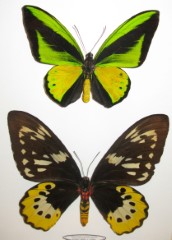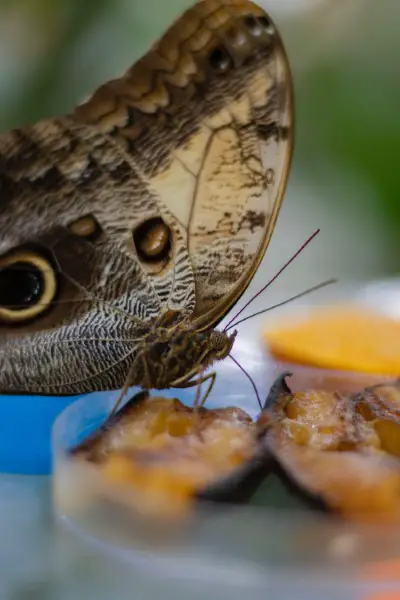Butterflies look fairly large and obvious when they’re flying, so you have to wonder if they have any kind of protection mechanisms at all? Here we’re going to look at what protection mechanisms they do have available to them.
So first of all, here’s the quick answer, then we’ll look in a little more detail…
How Do Butterflies Protect Themselves? Butterflies protect themselves using a number of methods. Those being camouflage, poison, mimicry and different flying patterns. However, camouflage is the primary method of protection butterflies use. This is when a butterfly blends into the environment making it difficult to spot them.
However, the other methods used to protect themselves also have their specialties and significances. So to give you a better understanding of the different options butterfly’s use to protect themselves, below is a clear breakdown of a butterflies protection methods.
Camouflage
This is the primary method of protection butterflies use to protect themselves. Most varieties of butterflies and even moths protect themselves from predators through camouflage.
Some butterflies blend themselves into an environment that they’ve evolved to adapt with, usually, this is some kind of vegetation. They can blend in so well in fact, that it can be almost impossible to spot them, even if they’re resting on an obvious branch or leaf quite close.
Some butterfly wings are designed specially to look like vegetation or tree bark, giving them the camouflage ability. So their camouflage can include vegetation such as dead leaves (like the blue oak leaf). While some others can look very much like the bark of a tree.
Some butterflies even have transparent wings. This easily helps butterflies to slide away from predators unseen.
Poison and Coloring
Another option butterflies use to protect themselves is that some butterflies are poisonous, to the point that if a predator should eat one they may become sick. It can cause the predator to vomit violently, thereby making the predator quickly learn not to prey on these types of butterflies.
This also helps predators to develop an aversion to any other butterflies that may resemble the one that made them ill. This is known as Aposematic Coloring.

Image By Anaxibia
For example, the Goliath Birdwing is a poisonous butterfly from Indonesia with bright and vibrant colors.
These colors specifically remind any experienced predator (those who ate one in the past and fell ill) that it does not taste good and will cause it to fall ill as a learned response.
And so they’ll avoid preying on similar butterfly species.
Similarly, other poisonous butterflies such as monarch butterflies eat toxic plants. Mostly monarch butterflies feed on milkweed. Butterflies are immune to the poison and they tend to sequester it in their bodies rather than excrete it. This sequestration of this toxic substance is what causes the predator to fall sick when it eats the butterflies.
All in all one thing that quite evidently clear is that in using the poisoning technique to protect themselves, a butterfly first will have to sacrifice its own life to save the lives of many of its kind. Only when a predator preys on a butterfly and falls sick, it will avoid preying on similar patterns of butterflies in the future.
Mimicry – Patterns
This is another option that butterflies use to protect themselves where butterflies have similar markings on their wings of an unrelated species. This is a way of fooling their predators. This is where butterflies have evolved from caterpillars taking wing colors and patterns that look exactly like those of the toxic species. This phenomenon is called mimicry which can happen in two ways as follows.
- Batesian mimicry
This is where a non-poisonous butterfly has markings on the wings that are similar to a poisonous species. In this way, the butterflies mimic itself as a harmful prey that predators would have once consumed and fallen sick. This will thereby avoid predators from eating the butterfly (which it thinks is from a poisonous species) and thereby protecting the mimicking butterfly.
- Mullerian mimicry
This is where two poisonous species have similar markings. Like I said above few insects will have to be sacrificed first to teach the predators to stay away from similar kind of species. The poisonous Viceroy mimics the poisonous Monarch butterfly.
Eye shapes on wings
This is quite an interesting way of protecting the butterflies tend to use. This is where butterflies have enormous spots on their wings which look like huge eyes. This makes the butterflies look much larger when their wings are spread. This is would then scare away the predators and also surprising potential predators.

Flying – Flying patterns and speed
Finally, the flying patterns are another major defense butterflies use to protect themselves. The speed and flying patterns of butterflies for defensive purpose vary from one species to another.
In general, the poisonous species of butterflies fly slower than non-poisonous species. It’s also important to remember that in general, all butterflies are fast fliers.
The fastest flying butterflies can fly up to 30 miles per hour or even more. In terms of flying patterns, butterflies use a fluttering motion that makes it difficult for a predator to predict where the butterflies will move next – but not impossible, unfortunately!
To close…
We hope this has helped you understand how butterfly protection methods, and how Butterflies defend themselves from predators. At some point, we’ll look at what does actually predate butterflies. But for now, we’ll just stay safe in the knowledge that they’re able to look after themselves – at least to some degree.
Here are some helpful resources if you want to study butterfly protection mechanisms further at home or in the classroom.
